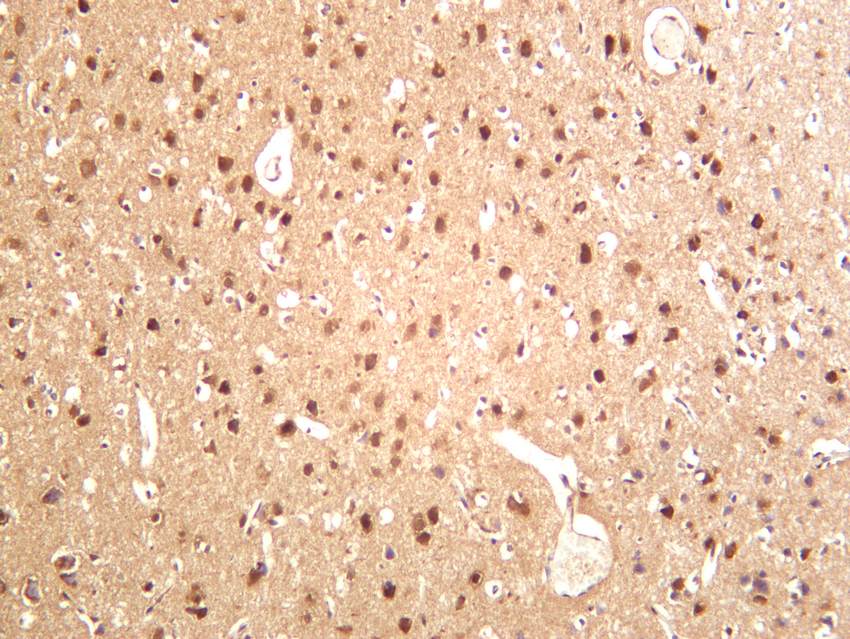PAK1 (PT0342R) PT® Rabbit mAb
- Catalog No.:YM8201
- Applications:WB;IHC;IF;IP;ELISA
- Reactivity:Human; Mouse; Rat;
- Target:
- PAK1
- Fields:
- >>MAPK signaling pathway;>>ErbB signaling pathway;>>Ras signaling pathway;>>cAMP signaling pathway;>>Chemokine signaling pathway;>>Axon guidance;>>Hippo signaling pathway - multiple species;>>Focal adhesion;>>C-type lectin receptor signaling pathway;>>Natural killer cell mediated cytotoxicity;>>T cell receptor signaling pathway;>>Fc gamma R-mediated phagocytosis;>>Regulation of actin cytoskeleton;>>Epithelial cell signaling in Helicobacter pylori infection;>>Pathogenic Escherichia coli infection;>>Salmonella infection;>>Human immunodeficiency virus 1 infection;>>Proteoglycans in cancer;>>Renal cell carcinoma
- Gene Name:
- PAK1
- Protein Name:
- Serine/threonine-protein kinase PAK 1
- Human Gene Id:
- 5058
- Human Swiss Prot No:
- Q13153
- Mouse Swiss Prot No:
- O88643
- Rat Gene Id:
- 29431
- Rat Swiss Prot No:
- P35465
- Specificity:
- endogenous
- Formulation:
- PBS, 50% glycerol, 0.05% Proclin 300, 0.05%BSA
- Source:
- Monoclonal, rabbit, IgG, Kappa
- Dilution:
- IHC 1:200-1:1000;WB 1:1000-1:5000;IF 1:200-1:1000;ELISA 1:5000-1:20000;IP 1:50-1:200;
- Purification:
- Protein A
- Storage Stability:
- -15°C to -25°C/1 year(Do not lower than -25°C)
- Other Name:
- PAK1;Serine/threonine-protein kinase PAK 1;Alpha-PAK;p21-activated kinase 1;PAK-1;p65-PAK
- Molecular Weight(Da):
- 61kD
- Observed Band(KD):
- 61kD
- Background:
- This gene encodes a family member of serine/threonine p21-activating kinases, known as PAK proteins. These proteins are critical effectors that link RhoGTPases to cytoskeleton reorganization and nuclear signaling, and they serve as targets for the small GTP binding proteins Cdc42 and Rac. This specific family member regulates cell motility and morphology. Alternatively spliced transcript variants encoding different isoforms have been found for this gene. [provided by RefSeq, Apr 2010],
- Function:
- catalytic activity:ATP + a protein = ADP + a phosphoprotein.,cofactor:Magnesium.,enzyme regulation:Activated by binding small G proteins. Binding of GTP-bound CDC42 or RAC1 to the autoregulatory region releases monomers from the autoinhibited dimer, enables phosphorylation of Thr-423 and allows the kinase domain to adopt an active structure. Also activated by binding to GTP-bound CDC42, independent of the phosphorylation state of Thr-423. Phosphorylation of Thr-84 by OXSR1 inhibits this activation.,function:The activated kinase acts on a variety of targets. Likely to be the GTPase effector that links the Rho-related GTPases to the JNK MAP kinase pathway. Activated by CDC42 and RAC1. Involved in dissolution of stress fibers and reorganization of focal complexes. Involved in regulation of microtubule biogenesis through phosphorylation of TBCB. Activity is inhibited in cells undergoing apop
- Subcellular Location:
- Cytoplasm
- Expression:
- Overexpressed in gastric cancer cells and tissues (at protein level) (PubMed:25766321).
- June 19-2018
- WESTERN IMMUNOBLOTTING PROTOCOL
- June 19-2018
- IMMUNOHISTOCHEMISTRY-PARAFFIN PROTOCOL
- June 19-2018
- IMMUNOFLUORESCENCE PROTOCOL
- September 08-2020
- FLOW-CYTOMEYRT-PROTOCOL
- May 20-2022
- Cell-Based ELISA│解您多样本WB检测之困扰
- July 13-2018
- CELL-BASED-ELISA-PROTOCOL-FOR-ACETYL-PROTEIN
- July 13-2018
- CELL-BASED-ELISA-PROTOCOL-FOR-PHOSPHO-PROTEIN
- July 13-2018
- Antibody-FAQs
- Products Images

- Various whole cell lysates were separated by 4-20% SDS-PAGE, and the membrane was blotted with anti-PAK1 (PT0342R) antibody. The HRP-conjugated Goat anti-Rabbit IgG(H + L) antibody was used to detect the antibody. Lane 1: Hela Lane 2: C6 Lane 3: Jurkat Lane 4: U-14 Predicted band size: 61kDa Observed band size: 61kDa

- Human brain was stained with anti-PAK1 (PT0342R) rabbit antibody

- Human hepatocellular carcinoma was stained with anti-PAK1 (PT0342R) rabbit antibody

- Rat brain was stained with anti-PAK1 (PT0342R) rabbit antibody



